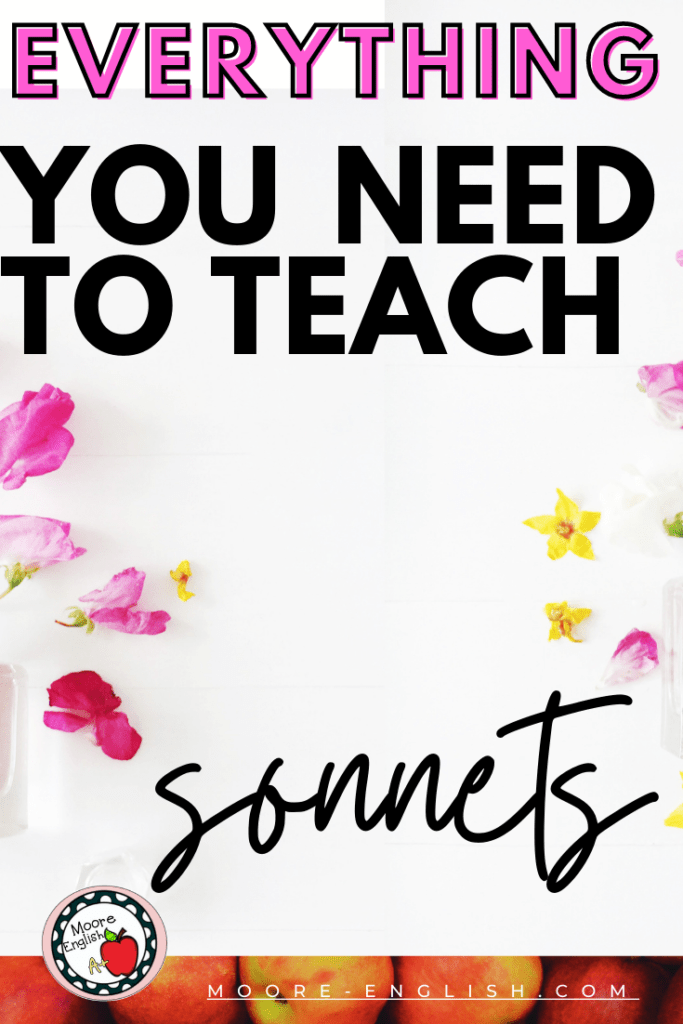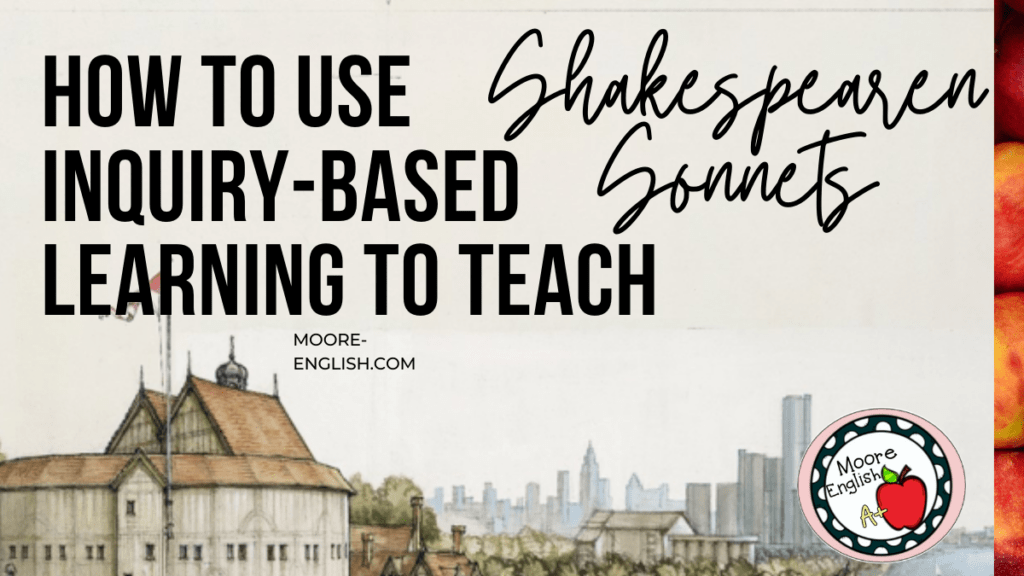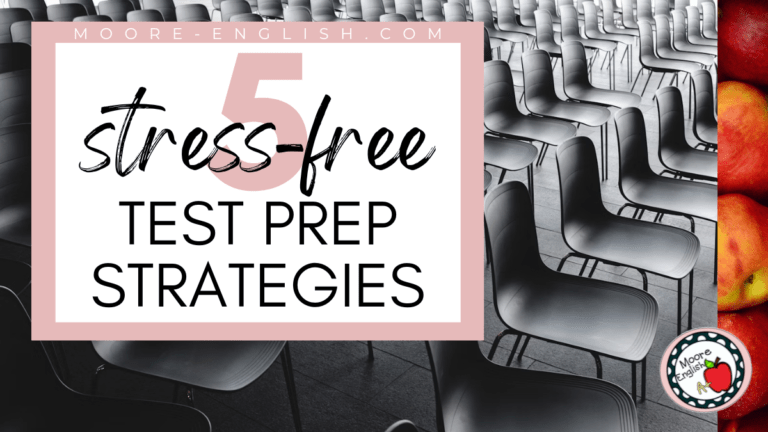Shakespearean or English sonnets remain part of many high school English classes. Regardless of how you feel about Shakespeare personally, sonnets are a great way to help students see the connection between poetry, structure, meter, and meaning. Today I wanted to share my favorite lesson for introducing sonnets and some resources for teaching sonnets:
This lesson has a few foundational New Critical tenets:
- Firstly, structure points to meaning. As Neil Postman tells us in “The Medium is the Metaphor,” the first chapter of Amusing Ourselves to Death, “each medium…makes possible a unique mode of discourse.” Each medium of communication works “to enforce [its] special definitions of reality.” In the case of Shakespearean sonnets, that reality relates to the intersection between reflection, confession, and love.
- Second, deviations from structure, then, also signify meaning. When students apply the four steps for pre-reading poetry, they begin to see the inner workings of a poem. For this reason, when students see deviations from the norm, they begin to see how the poem works against and for and toward its unified self.
- Thirdly, meter matters. For the first five years of my career, I ignored meter. I thought it was too hard for my students. While meter is challenging, being able to detect meter and see its deviations helps students pinpoint key shifts and changes in meaning. I don’t need students to be able to name every iamb, dactyl, and trochee. However, counting syllables and their deviations can be tremendously powerful in terms of analysis.
- Finally, these foundational principles help students approach poetry far more complex than Shakespearean sonnets. Additionally, post-modern and contemporary poetry takes a tremendous amount of its power from its rejection of traditional modes of communication. At times, post-modern writers use traditional techniques to make a totally new point. Overall, students who can see the foundations of poetry will be able to appreciate poetry academically and emotionally.
This post this post may contain affiliate links. Please read the Terms of Use.
Day One of Shakespearean Sonnets
When I was in school, a British literature teacher gave us a note sheet and lecture about the characteristics of a Shakespearean sonnet. The lesson was not memorable.
Rather than repeat this cycle with my own students, I use inquiry-based learning to engage my students in Shakespearean sonnets.
First, I want students to be engaged in this lesson, so rather than beginning with Sonnet 116, I start by selecting 6-10 sonnets from Pop Sonnets by Erik Didriksen. In this book, Didriksen has turned more than 100 classic pop songs into Shakespearean sonnets. In particular, I recommend his take on The Fresh Prince of Bel-Air theme song.
Then, I copy and print or scan each of those poems, carefully removing the song title.
Next, I put students into groups and give each group a pop sonnet. If you have a longer class period, you can give each group 6-10 sonnets to identify.
Then, student groups read each pop sonnet to try to determine which song Didriksen is transforming. This process requires students to read closely, analyze figurative language, and practice context-clues skills. For extra engagement, you can make this a contest to see which group can identify their song(s) first.
Finally, we come back together as a class so each group can share their pop sonnet and explain to their classmates how they identified the popular tune.
Day Two of Shakespearean Sonnets
After students have identified their Pop Sonnets, I pass the pop sonnets back out to students. I explain that each pop sonnet is a Shakespearean sonnet. From here, I ask each group to try to identify the characteristics of a Shakespearean sonnet. In particular, I’m looking for students to recognize that Shakespearean sonnets have 14 lines, a specific rhyme scheme, and a clear turn.
Usually, student groups can identify the line count and rhyme scheme. (Remember that my students usually know the four steps for pre-reading poetry at this point.)
As the students reach peak frustration trying to determine the characteristics of a Shakespearean sonnet, I bring the class back together to consider the meter. As a class, we identify the familiar iambic pentameter of Shakespeare’s writing. Depending on the class, I don’t often require students to know the words “iambic pentameter,” but it’s helpful if students know that a line of Shakespearean verse has ten beats or syllables. Counting syllables may seem like an arcane skill, but being able to scan a line of poetry helps students determine where the count deviates. And when students can see a deviation in the verse, they can find a poem’s turn or look toward author’s purpose.
At the end of this class, students have a list of the characteristics of a Shakespearean sonnet. We have introduced new vocabulary like “quatraine” and “couplet,” and we’re ready to read a true Shakespearean sonnet tomorrow.
Day Three with Shakespearean Sonnets
At the beginning of day three, students complete a Quick Write or Braindump in which they try to list everything they know about Shakespearean sonnets.
Then, we use our Braindump to put some basic annotations on one of Shakespeare’s sonnets. One of my favorite things about annotating a poem with a class is that no two classes ever end up with the same annotations. Letting classes drive their own annotations, making connections, pointing to details that seem interesting–these are all ways not to kill a of poetry.
At the end of Day 3, I make a quick formative assessment. Do students need to annotate another poem with me? Should I assess their analytical mettel by giving them a few questions to answer? Or are they ready to independently read and annotate a sonnet?
Days Four and Five
When working with Shakespearean sonnets, my favorite day comes when I ask students to write their own sonnets. While I explain that student’s sonnets must be original, they do not have to focus on romantic love. In fact, some of my favorite student sonnets have been about love for Taco Bell. Another student memorably wrote a sonnet from the perspective of the French Revolution: her work was a darkly funny love poem for the guillotine. Of course, some students have also written truly comedic gems!
To help guide students through their sonnets, I use this rubric. It’s free, Google ready, and 100% editable!
After students have had some time to write their sonnets, we hold our own mini-poetry slam! When there’s not a pandemic going on, students bring in food to share. This year we will bring in individually wrapped snacks or, if we’re distance learning, host our poetry slam virtually!
More Sonnet Resources
- Crash Course Literature has an episode about Shakespearean sonnets. With John Green, students can analyze three of Shakespeare’s best-known sonnets. Watch the episode here, and get my listening guide.
- Teaching students about meter can be tricky. Here is a Ted-ed video to help students breakdown meter, especially Shakespeare’s favorite iambic pentameter.
- All the Sonnets of Shakespeare by Paul Edmondson and Stanley Wells is a book that provides all the fascinating details about the intersection between Shakespeare’s sonnets and his personal and professional lives.
- “How to Think Like a Sonnet, or Fourteen Ways of Looking Around a Room” by Scott Newstok is a great list of strategies for engaging Shakespearean sonnets, including links and notes that are fun and insightful.
- For Better or for Verse is a free website from the University of Virginia Department of English. The site describes itself as “An interactive learning tool that can help you understand what makes metered poetry in English tick.” Students see a poem on the screen and then can practice marking feet and stresses. For a challenge, they can also practice naming the types of stress.
- For pure fun, you can recall the early days of this pandemic when we were all under shelter-in-place orders and our favorite actors were reading Shakespearean sonnets to us! Here’s Patrick Stewart and other great actors!
- Inquiry-based learning is one of my favorite instruction strategies. I use similar lessons when I introduce parallelism and aphorisms.


























